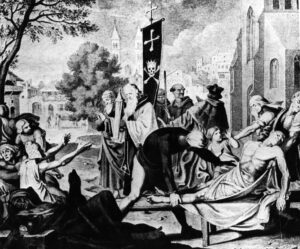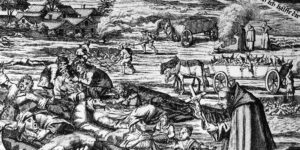Black Death Pandemic- Dark Death was a pandemic that desolated Europe between 1347 and 1351, taking a proportionately more prominent cost of life than some other known scourge or battle up to that time.
The Black Death is generally accepted to have been the aftereffect of a plague brought about by contamination with the bacterium Yersinia pestis. Present-day hereditary examinations show that the type of Y. pestis presented during the Black Death is genetic to all surviving flowing Y. pestis strains are known to cause illness in individuals.
Consequently, the starting of the current plague pestilences lies in the archaic period. Other logical proof has shown that the Black Death might have been viral initially. Having begun in China and Inner Asia, the Black Death devastated the multitude of the Kipchak khan Janibeg while he was assaulting the Genoese exchanging port of Kaffa (presently Feodosiya) in Crimea (1347). With his powers breaking down, Janibeg launched plague-pervaded corpses into the town with the end goal of tainting his adversaries.
From Kaffa, Genoese boats conveyed the scourge toward the west to Mediterranean ports, whence it spread inland, influencing Sicily (1347); North Africa, the central area of Italy, Spain, and France (1348); and Austria, Hungary, Switzerland, Germany, and the Low Countries (1349). A boat from Calais conveyed the plague to Melcombe Regis, Dorset, in August 1348. It arrived at Bristol very quickly and spread quickly all through the southwestern areas of England.

London experienced most viciously among February and May 1349, East Anglia and Yorkshire throughout that mid-year. The Black Death arrived at the super north of England, Scotland, Scandinavia, and the Baltic nations in 1350. There were repeats of the plague in 1361-63, 1369-71, 1374-75, 1390, and 1400. Current exploration has proposed that, over that timeframe, the plague was brought into Europe on numerous occasions, going along shipping lanes in waves.
The pace of mortality from the Black Death differed from one spot to another: though a few locales, like the duchy of Milan, Flanders, and Béarn, appear to have gotten away relatively softly, others, like Tuscany, Aragon, Catalonia, and Languedoc, were exceptionally hard-hit.
Towns, where the risk of the virus was more noteworthy, were more impacted than the open country. Inside the cities, the religious networks gave the most elevated frequency of casualties. Indeed, even the extraordinary and vital, who were more equipped for flight, were struck down: among sovereignty, Eleanor, sovereign of Peter IV of Aragon, and King Alfonso XI of Castile surrendered, and Joan, a girl of the English ruler Edward III, passed on at Bordeaux en route to her wedding with Alfonso’s child.

Canterbury lost two progressive diocese supervisors, John de Stratford and Thomas Bradwardine; Petrarch lost not just Laura, who propelled so many of his sonnets, but his benefactor, Giovanni Cardinal Colonna. The ecclesiastical court at Avignon was decreased by one-fourth.
Entire people groups and families were at times obliterated. The results of this vicious calamity were a large number. An end of wars and an unexpected rut quickly followed; however, they were exclusive of the brief term. A severe and enduring result was the extreme decrease in how much land was under development because of the passing of countless workers.

This ended up being the destruction of numerous landowners. The deficiency of work constrained them to substitute wages or cash rents instead of work administrations with an end goal to keep their occupants. There was likewise a general ascent in compensation for artisans and workers.
These progressions carried another ease to the, until recently, slight separation of society. The mental impacts of the Black Death were reflected north of the Alps (not in Italy) by a distraction with death and the hereafter manifested in verse, model, and painting; the Roman Catholic Church lost a portion of its syndication over the salvation of spirits as individuals went to magic and at times to abundances.
Semitism escalated throughout Europe as Jews were faulted for the spread of the Black Death. A rush of savage slaughters resulted, and the whole Jewish people group were killed by hordes or consumed at stake all at once.
The economy of Siena got a final check. The city’s populace was decreased to the point that the undertaking of expanding the house of prayer was deserted, and the demise of numerous incredible painters, for example, Ambrogio and Pietro Lorenzetti, finished the improvement of the top Sienese school up.
In England, the immediate impacts of the pestilence of 1349 appear to have been of brief span, and the monetary downfall which arrived at its nadir during the fifteenth century ought to most likely be ascribed instead to the pandemic repeat of the plague.
Irresistible illnesses, for example, flu, can spread quickly — once in a while surprisingly fast — among the individuals living in various regions of the world. The spread of an illness is worked with by a few variables, including an expanded level of irresistibleness of the sickness causing specialist, human-to-human transmission of the infection, and present-day transportation methods, for example, air travel.
Most of the exceptionally irresistible ailments that happen in people are brought about by illnesses that first emerge in quite a while. In this way, when another compelling specialist or disease arises in creatures, reconnaissance associations situated inside impacted regions are liable for alarming the World Health Organization (WHO) and for intently checking the way of behaving of the irresistible specialist and the movement spread of the sickness.
WHO continually screens illness action worldwide through an organisation of reconnaissance focuses situated in nations worldwide.
Over the entire course of time, pandemics of illnesses like cholera, plague, and flu play had a significant impact on moulding human civilisations. Instances of massive authentic pandemics remember the plague pandemic of the Byzantine Empire in the sixth century CE; the Black Death, which started in China and spread across Europe in the fourteenth 100 years; and the flu pandemic of 1918-19, which began in the U.S. province of Kansas and spread to Europe, Asia, and islands in the South Pacific.
Even though pandemics are commonly portrayed by their event over a limited capacity to focus time, today, a few irresistible illnesses continue at a high frequency, happen worldwide, and can be communicated between people straightforwardly or in a roundabout way.
Such diseases addressed in current pandemics incorporate AIDS, brought about by HIV (human immunodeficiency infection), which is sent straightforwardly among people; and jungle fever, brought about by parasites in the class Plasmodium, which are communicated starting with one human and then onto the next by mosquitoes that feed on the blood of contaminated people.